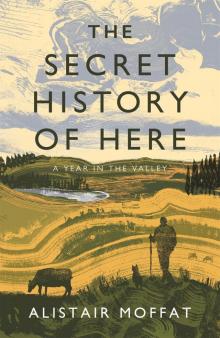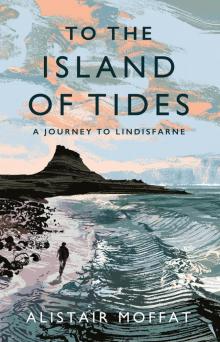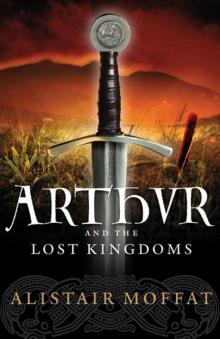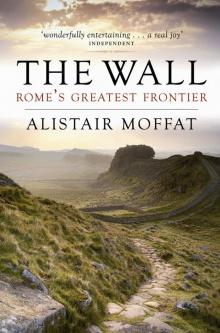- Home
- Alistair Moffat
The Faded Map: The Lost Kingdoms of Scotland Page 2
The Faded Map: The Lost Kingdoms of Scotland Read online
Page 2
great mead-hall meant to be a wonder of the world for ever; it would be his throne-room and there he would dispense his God-given goods to young and old . . . The hall towered, its gables wide and high.
To the west of the Catrail few shadows remain. The kings of the west spoke Old Welsh to their warriors and their people, and the only recognisable legacy is the persistence of their ancient place-names. Indeed the frontier marks a striking division, even on a modern map. To the west, the landscape is speckled by many Old Welsh names. The poet and novelist James Hogg farmed at Altrieve in the Yarrow Valley. The older version is Eltref, which means ‘Old Farmstead’ in early Welsh. Some names, like Berrybush, sound very English but are not. Bar y Bwlch is the correct derivation and it means ‘The Summit of the Pass’. Pen is Old Welsh for ‘head’ or ‘a high hill’ and place-names with pen abound in the western borders – Ettrick Pen, Penmanshiels, Pennygant Hill.
As the line of Catrail climbs west and up the Yarrow Valley, walkers come upon a much more substantial section. It bears an intriguing name, one which does more than hint at the purpose of the frontier. At first glance, Wallace’s Trench sounds like a reference to the famous Scottish hero of the Wars of Independence. He campaigned in the Borders and, with his force of guerrilla fighters, hid in the wastes of the Ettrick Forest before being proclaimed Guardian of Scotland at the Forest Kirk in Selkirk. But why would a guerrilla fighter have his men dig a huge trench on the hillsides of the Yarrow Valley? Siege or attritional warfare was no part of Wallace’s purpose. The historical reality is different – and fascinating.
Wallace’s Trench long predates William and indeed has nothing to do with his exploits and everything to do with his name. In such records as survive, it is variously spelled as Wallensis, Walays and Le Waleis. All of these versions mean the same thing – ‘William the Welshman’. To the great relief of many patriots, he did not come from Wales but Clydesdale in the old and half-forgotten kingdom of Strathclyde and his name probably recalls a native lineage which clung on to the old language – in other words, they continued to speak a dialect of Old Welsh into the early medieval period. Wallace’s Trench is therefore the Welshmen’s Trench, part of the long boundary between a developing English-speaking culture to the east and an ancient Celtic speech surviving in the hills to the west.
Place names support this interpretation and there is a striking clutch of them around Wallace’s Trench. One in particular suggests a military tone. Tinnis occurs four times and it derives from the Welsh dinas meaning ‘a fort’. And rising up west of the trench is Welshie’s Law, probably a blunt, later echo of old differences.
Power names places and, when the English war bands penetrated far up the Tweed and Teviot valleys, their lords reordered the map. Many Welsh place-names gave way to new English names, especially when these were centres of wealth and prestige. At Sprouston, a small village on the southern bank of the Tweed near Kelso, there was a royal English township. Some time around 657, it was visited by a great man, probably King Oswiu of Northumberland, the Overlord of Britain or Bretwalda. Sprouston is a very early English name, after a man called something like Sprow, but the fact that it was a royal settlement with a great hall speaks of consolidation and firm ownership. If the Catrail was the frontier between Celtic and English kingship in the Borders, it lay far to the west and recognised that the fertile river lands of the plains had fallen to the invader and the hill country was all that was left to the defeated.
It is possible to hold up a map of Scotland and see the faint watermark of its lost kingdoms. Long earthworks pattern the landscape, running through fields, climbing hillsides, apparently leading nowhere, and enigmatic names remember the grass-covered undulations of ancient fortresses. Again, in the Borders, there is an elaborate structure known as the Military Road. It runs for about four miles and is not a road or track but an elaborate sequence of two banks and two ditches, the deposit of tremendous and well-organised labour. Historians have conjectured its construction to the first millennium BC and believe it to be related to the great hill fort on Eildon Hill North. The Military Road seems to guard the south-western approaches to the hills, and its function may have been to slow down an attack or prevent the rapid escape of raiders laden with plunder long enough for defenders to reach it.
In Perthshire, archaeologists have uncovered the Roman frontier of the Gask Ridge, a series of watchtowers strung out in a line between Dunblane and Perth. Probably built by the legions commanded by the Governor of Britannia, Petilius Cerialis, some time around AD 73, it appears to have followed a preexisting tribal boundary. To the west and north of the Gask Ridge ruled the kings of Caledonia while, to the east, occupying Fife and Kinross, lay the territory of the Venicones. Their Latinised name has been brilliantly parsed by an American scholar and it translates as ‘the Kindred Hounds’.
Sometimes the memories of lost kingdoms are substantial, well documented and remnants survive. Strathclyde lasted until 1014 when one of its last kings, Owain, was killed in battle with the English at Carham on the banks of the Tweed and lingered almost certainly as late as 1070 when, according to one source, it was ‘violently subjugated’ by the kings of Scots. Others are little more than a few scattered fragments of a jigsaw. The kingdom of the Wildcats was undoubtedly powerful on both shores of the Moray Firth and its soldiers were willing to fight in its name as late as 1746. At Culloden, Clan Chattan fought with hopeless savagery. One of their captains, Gillies MacBean, killed fourteen government soldiers before his leg was shattered by grapeshot. When dragoons cornered the wounded man by a drystane dyke, Mac-Bean fought like a man possessed before being trampled by English horses. But who were the Wildcats? Caithness is named for them. Gaels call the Duke of Sutherland ‘Morair Chat’, his coastland ‘Machair Chat’ and the hill country ‘Monadh Chat’.
Perhaps the most amazing survival is the kingdom of Manau. Its heartland lasted until 1974 in the shape of Clackmannanshire, Scotland’s smallest county. Ignored by all but antiquaries, its talisman stands next to the old county buildings in Clackmannan. Clach na Manau is the Gaelic version of the origin name for the Stone of Manau, the core of the ancient kingdom and the derivation of Clackmannan.
These are not Ruritanian curiosities. The lost kingdoms of Scotland remember not only who we were before we thought of ourselves as Scots but, in so doing, they help unpack a much richer identity. They also remind us of political possibilities. If the Gaelic-speaking kings of Argyll had been less aggressive and less lucky, we might have lived under the rule of the Strathclyde dynasty. And we might have been worrying about the health of our native Welsh speech community or how fewer and fewer in the north were now speaking Pictish. What follows shows that Scotland was indeed never inevitable.
* * *
The Kingdom of Moray
The ancient kingdom of Moray – or Moreb, an Old Welsh name meaning ‘low-lying land by the sea’ – was much larger than the modern county of Moray. Almost certainly the descendant of the Pictish kingdom of Fidach, it extended around both shores of the Moray Firth, running from Buchan in the east, taking in the lower Spey, Inverness and the north of the Great Glen and circling north up to Caithness. Even further back in history, it encompassed the old territories of the Cat People, what became the confederacy of Clan Chattan. A kingdom centred on the sea and the firth it bordered, its southern land frontier was the Grampian massif and the point near modern Stone-haven, known as the Mounth, where the massif almost reaches the shore of the North Sea. Two kings of Moray are noted in the Icelandic sagas in the tenth century – Mael Snechtai and Mael Coluim. These are Gaelic names and scions of a vigorous dynasty. The most famous king of Moray became king of Alba or Scotland and ruled between 1040 and 1057. This was Macbeth, a much more successful ruler than Shakespeare’s drama allowed. Kings of Moray were seen as serious rivals to the line of Malcolm Canmore and, in 1130, his son, David I, mac Malcolm, finally annexed the old kingdom. He brought groups of settlers from the royal lands around the Tweed
and these plantations were made on good land along the southern coasts of the Moray Firth. David I’s policy created a linguistic frontier which can still be heard today. Between Inverness and Elgin, the local accent changes noticeably. This is because those from Inverness speak English learned by their Gaelic-speaking ancestors from the recent past while those to the east came from the south in the twelfth century and were already English speakers.
* * *
2
The Faded Map
SOME TIME AROUND 320 BC, almost certainly in the benign months of the summer, a Greek explorer and scientist visited the land that would become Scotland. Pytheas had travelled an immense distance, beginning his remarkable and little-known journey at the prosperous trading colony of Massilia, modern Marseilles. He came north in search of knowledge, business opportunities and excitement. All three were recorded in On the Ocean, written on the traveller’s safe return to the warmth of the Mediterranean. This fascinating book has been lost for almost two thousand years and all knowledge of it is derived from passages used in the surviving texts of later classical authors.
None of these scholars had visited Britain or Scotland and all of them depended on Pytheas’ first-hand account. Some only included excerpts to mock him, calling him a liar and a fantasist. It was well known that human beings could not live in the hostile climate of the far north and the Greek explorer had simply made it all up. Others believed him intrepid and still more plagiarised his work without attribution. From an aggregate of all these references and some reasonable assumptions, it is possible to trace the voyage of Pytheas and even glimpse an occasional sense of what he saw.
As a serious scientist, Pytheas carried with him instruments capable of very accurate measurements and possessed enough geographical knowledge to translate his observations into data. At midday, with a cloudless sky, he could calculate the height of the sun and this allowed him to work out how far north he had travelled from Marseilles. These measurements were later expressed as latitudes and, in turn, showed where Pytheas had been when he made them. One was almost certainly recorded on the Isle of Man. From there he sailed up through the North Channel, his shipmaster no doubt avoiding the boiling tide rips off the Mull of Galloway where the Atlantic surges in to meet the Irish Sea. Likely to have hugged the coast, both to take on regular supplies of fresh water and readily find safe night anchorages (early sailors were very reluctant to travel in darkness), captains preferred to voyage in short stages. And Pytheas slowly threaded his way up through the archipelagos of the Inner and Outer Hebrides. His ship made landfall at the Point Peninsula on the eastern coast of the Isle of Lewis. That was where he made his last measurement of the sun’s height, at the northern latitude of 54 degrees and 13 minutes, somewhere near the town of Stornoway.
* * *
Gnomon
Pytheas’ ability as a mathematician was especially extraordinary when the rudimentary nature of his instruments is understood. On his epic journey to Britain, he calculated latitude on five occasions and each time he used nothing more sophisticated than a straight stick. Known as a gnomon, it was planted in the ground at an angle of precisely 90 degrees at noon, when Pytheas judged the sun to be at its zenith. If this could be done at the summer solstice, particularly when in unfamiliar territory, then so much the better. What mattered was the length of the shadow cast by the gnomon and its ratio to the height of the stick itself. Having presumably made a measurement at Marseilles or knowing what the standard ratio was, Pytheas moved north and made four more calculations. As the cast shadow lengthened slightly and the ratio to the height of the gnomon changed, Pytheas could work out degrees of latitude accurately. Working backwards from his calculations, it is possible to trace the extent of his journey. He planted his gnomon in Brittany (48 degrees north), the Isle of Man (54 degrees), the Isle of Lewis (58 degrees) and Shetland (61 degrees). The great scholar and admirer of Pytheas, Sir Barry Cunliffe, believes that the intrepid Greek probably made it as far north as Iceland (66 degrees). Gnomons are still used. The term now describes the triangular upright in the middle of a sundial.
* * *
What is even more startling was the Greek traveller’s ability to work out distances very accurately. Reproduced in the work of another, later, Greek writer, Diodorus Siculus, here is Pytheas’ general description of Britain:
Britain is triangular in shape, much as is Sicily, but its sides are not equal. The island stretches obliquely along the coast of Europe, and the point where it is least distant from the continent, we are told, is the promontory which men call Kantion [Kent] and this is about one hundred stades [19 km] from the mainland, at the place where the sea has its outlet, whereas the second promontory, known as Belerion [Land’s End], is said to be a voyage of four days from the mainland, and the last, writers tell us, extends out into the open sea and is named Orkas [Dunnet Head – opposite the Orkneys]. Of the sides of Britain the shortest, which extends along Europe, is 7,500 stades [1,400 km], the second, from the Strait to the tip [at the north] is 15,000 stades [2,800km] and the last is 20,000 stades [3,700 km] so that the entire circuit of the island amounts to 42,500 stades [7,900 km].
What astonishes all who read that passage is that Pytheas got it almost exactly right. The length of the British coastline, with all its indentations and deceptive distances is 7,580 kilometres. With only estimates of the speed of his ship, local knowledge of tides and currents to go on, he managed a level of accuracy unknown before modern times.
What is also striking is Pytheas’ sense of enterprise in venturing into the unknown, far beyond the limits of Mediterranean knowledge of north-western Europe. With characteristic precision and reticence, Herodotus had mentioned the ‘Tin Islands’ that lay somewhere in the remote northern ocean but added immediately, ‘I cannot speak with any certainty’. Tin was an essential ingredient in the alloy of bronze and, since deposits were rare along the shores of the Mediterranean, Greek merchants were always anxious to find new sources. Pytheas’ epic journey was therefore not only motivated by curiosity and an evident sense of scientific enquiry but also by the needs of commerce. Tin was very valuable and, if the mists and monsters which guarded the chilly northern seas could be avoided, there was money to be made.
Contacts already existed. Tin was being regularly traded between southern Britain and the Mediterranean in the fourth century BC but almost certainly passing through several pairs of hands on its way south. If Pytheas could discover a feasible route from Marseilles to Britain, then perhaps a chain of expensive middlemen could be cut out.
He began his long journey overland, travelling first to the port of Narbonne and, from there, was probably rowed up the River Aude as far as the draught of a boat could reach and then onwards on foot or horseback up over the watershed and down to the headwaters of the River Garonne. From there a boat would have taken Pytheas quickly and comfortably to the great estuary of the Gironde and the Atlantic coast beyond.
This and several other overland and river routes to the north were well known to the Greek colonists of Marseilles and archaeology confirms a brisk trading network exchanging Mediterranean goods for the produce of the peoples of what is now France. On the shores of the Bay of Biscay, Pytheas will have found passage on local boats plying between shore markets further up the coast or possibly with merchants from his home port or with native traders who had done business with them. No doubt he avoided travelling alone and vulnerable – perhaps he had companions whose involvement is now lost to history. In any event, passage could be rapid and, if there were no significant breaks in his journey, the explorer could have found himself in Brittany, on the southern shores of the English Channel, less than 30 days after leaving Marseilles.
Pytheas was standing on the very edge of geography. As far as he knew, no Greek had come so far north and survived to record what he saw. Certainly Cornish tin was imported but none of his compatriots had come to the place called Belerion where it was panned from streams and hacked out of shallow pits. Non
e had seen the charcoal-burners smelt the ore into astragal-shaped ingots weighing about 80 kilograms although many had passed through the markets of Marseilles. Several of these remarkable objects have been found at various stages of their journey to the Mediterranean. They were brought to the beach market between St Michael’s Mount and Marazion on the Cornish coast, not far from Penzance. Once deals had been done and the tin loaded into boats, the rising tide refloated them and they trimmed their sails and swung away south out to sea. The sea captains navigated by pilotage, hugging the coastline, measuring progress by seamarks and crossing the Channel when the French coast came in sight, often at Cap Gris Nez.
Cost, convenience and speed dictated that a sea journey, safely managed in the summer months, was always to be preferred to the slow and dangerous business of transporting goods overland. Quantities were necessarily smaller and robbers lay in wait. When the tin ships arrived at the mouth of the Seine, the Loire or the Gironde, they travelled as far up the rivers as they could. At the point when the keels began to scrape the river bed or become clogged in mud, the 80-kilo astragals were unloaded and transferred to packhorses. Their figure-of-eight shape allowed two to be carried by each animal, slung on either side of a wooden packsaddle and lashed securely. The average packhorse could manage 160 kilos at a steady uphill walk without too much loss of condition. But these routes were only possible in summer when enough grass grew and could be grazed. Once a string of packhorses reached the banks of the River Rhône, the tin was untacked, set into boats and the current carried them quickly downstream to the sea and Marseilles.

 The Secret History of Here
The Secret History of Here The Night Before Morning
The Night Before Morning To the Island of Tides
To the Island of Tides Arthur and the Lost Kingdoms
Arthur and the Lost Kingdoms Britain’s Last Frontier
Britain’s Last Frontier The Faded Map: The Lost Kingdoms of Scotland
The Faded Map: The Lost Kingdoms of Scotland The Wall
The Wall